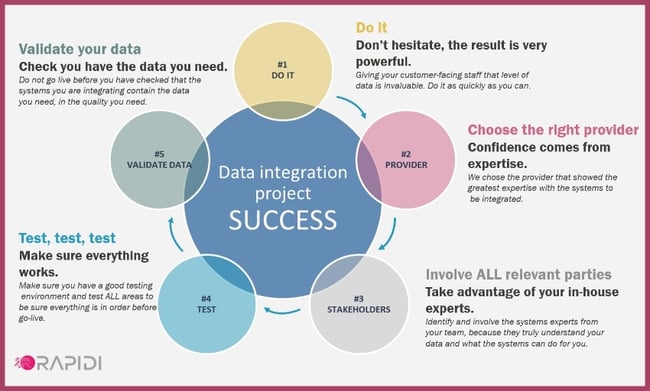To learn more about the success of data integration projects, it is important to study the cases of companies that have experienced such success.
This article is based on the learnings and best practices from dozens of companies that have managed to combine data and integrate their software solutions.
Some have chosen to sync data using house-made data integration solutions. Others decided to rely on the established experience of data integration providers.
In this article, we have evaluated the different methods and concluded on a recommended approach to data integration.
Successful data integration project: what does it mean?
Measuring the success of a data integration project is similar to measuring the success of any project. There are various methods that can be used to measure project success.
The SMART goals method lets you define precise goals that you can easily measure upon. It is based on the fact that any project should have goals that are: Specific, Measurable, Achievable, Relevant and Time-bound. This is indeed smart, but it is only a start.
Technology projects have their specificities. They are said to be some of the most complex and expensive projects. Most of all they have the reputation of being bound to fail if not handled properly.
More than any others, IT projects need:
- A well-defined and precise scope. The scope defines precisely how the project will meet the goals you have agreed upon.
- A closely monitored schedule. This is the time dimension of the project and its success depends upon a day to day monitoring, evaluation and adjustment.
- A quality that meets all stakeholders’ expectations and wishes. Quality assurance requires rigorous reviews and continuous evaluations.
- A realistic budget. Keeping within budget should always be a concern of yours to keep it under control.
- Customer satisfaction. Although it is highly subjective, this should be the main reason for the project, its red thread.

HOW TO SUCCESSFULLY INTEGRATE YOUR SYSTEMS?
Of all IT related projects, data integration projects can be some of the most complex. Consolidating data, setting up data flows, dealing with master data management and choosing data integration tools are not the easiest tasks to deal with.
Before being able to integrate data between your systems, you will need to fully understand your business processes. This way you will be able to define the best data integration processes to let you transfer data between your systems.
The exponential growth of collected data, big data and the more and more common use of data warehouses have not made the data integration job easier.
ETL (Extract Transform Load) is not the only data integration method available. Once you have chosen the method that suits your organization best, your concern will turn back to the essence of your project success: data quality.
Once you have evaluated data integration systems, real time or not, and when you have chosen the type of data you want to sync, it will be time to get started.
5 tips to successfully integrate data
Tip #1: do it. It does sound over simple, but the first best advice is to make the decision of integrating your systems. The first step in the right direction is always an important one.
Tip#2: Find the right data integration service provider. It is of course related to the data integration systems you choose, but not only. Finding the solution best suited to your needs is important.
Finding a data integration partner that specializes not only in data integration but also in the systems that you are integrating is just as important. For example, if you wish to integrate Salesforce with Microsoft Dynamics ERP solutions, Rapidi is a partner you should consider.
Rapidi offers a template-based solution to sync data between Salesforce and Dynamics ERP. The Rapidi staff is truly knowledgeable and experienced within both Salesforce and Microsoft Dynamics ERP. This ensures the best data integration experience possible before, during and after implementation.
Tip#3: Involve all relevant parties and stakeholders from the beginning. This way you will take advantage of the knowledge, know-how and experience of all involved parties. Also, you will secure the input of all.
Each party will have specific relevant input and you will need different points of view. And eventually, involving them early will secure the excitement and support of all stakeholders.
Tip#4: Make sure that your initial plans include a plan for testing. Making sure that all works as it should is an important part of your project. To secure its success, it is vital for you to have a good testing environment.
Then you must test, test, and test again until you are sure that all works as it should. Then only you will properly get ready for go-live.
Tip#5: Last but certainly not least, you will need to make sure that you know which data you wish to transfer and synchronize. When you have identified the data, you need to check its quality and make the necessary clean-ups and adjustments to achieve optimal data quality.












